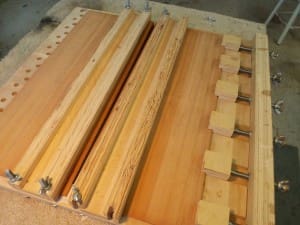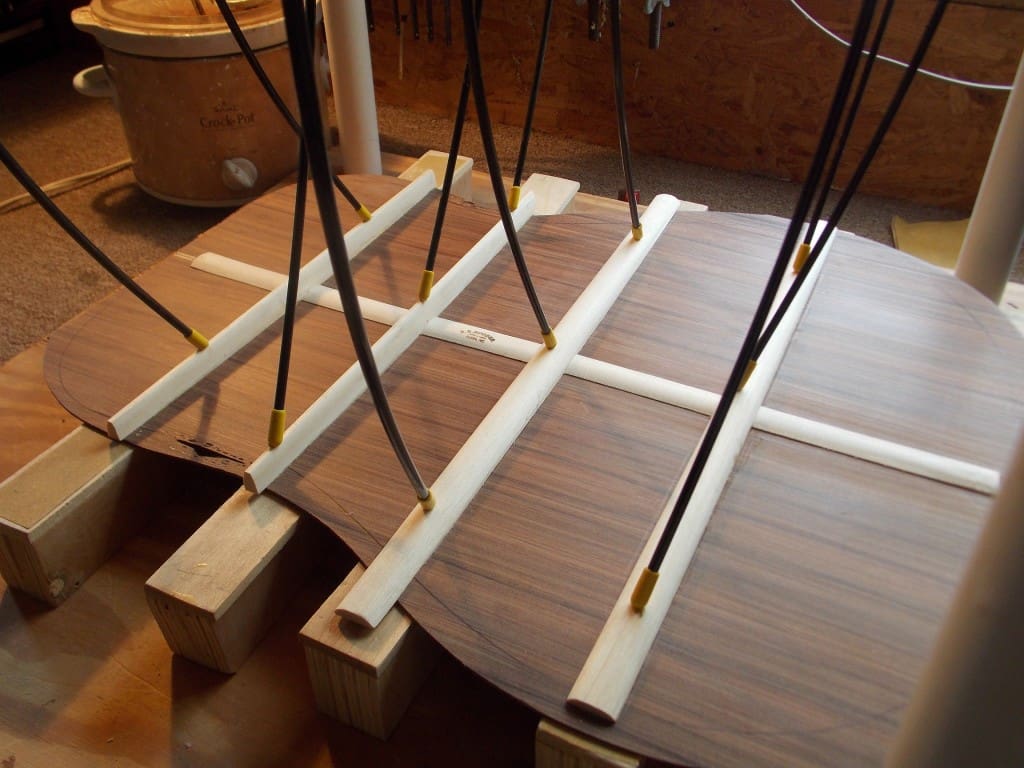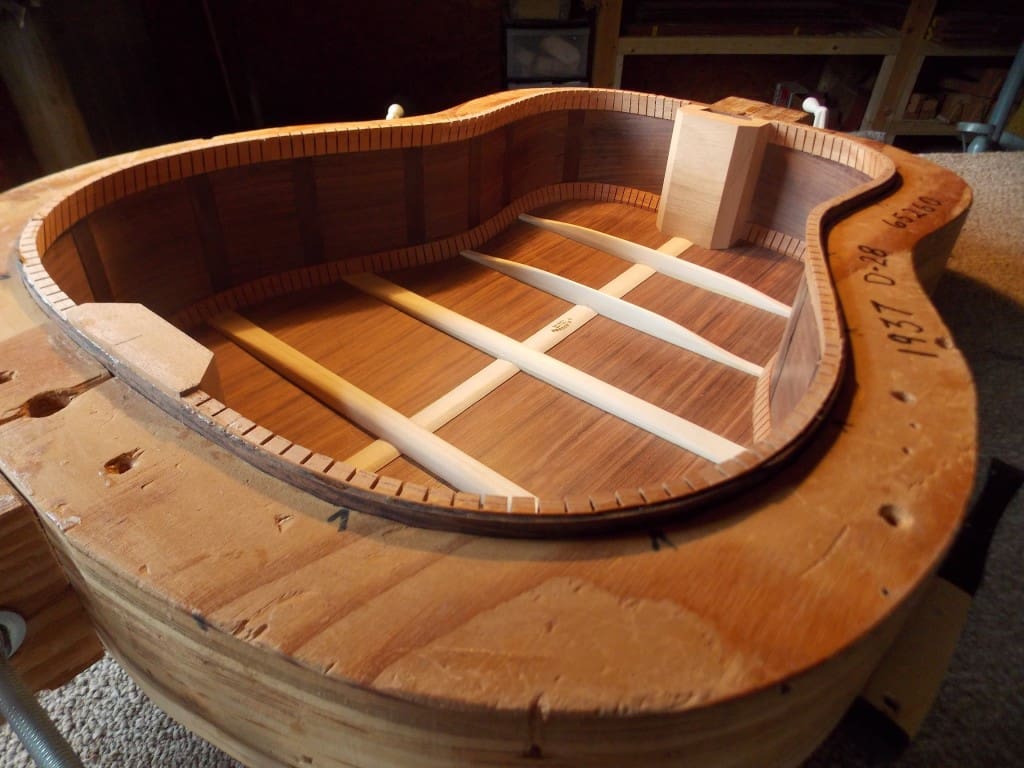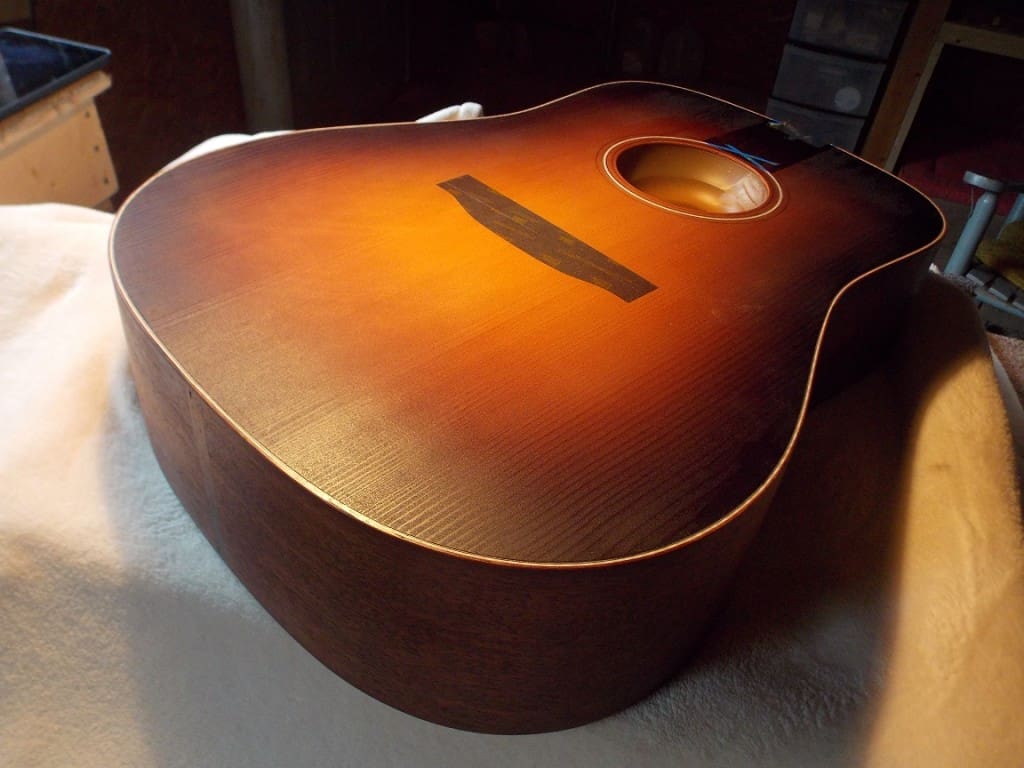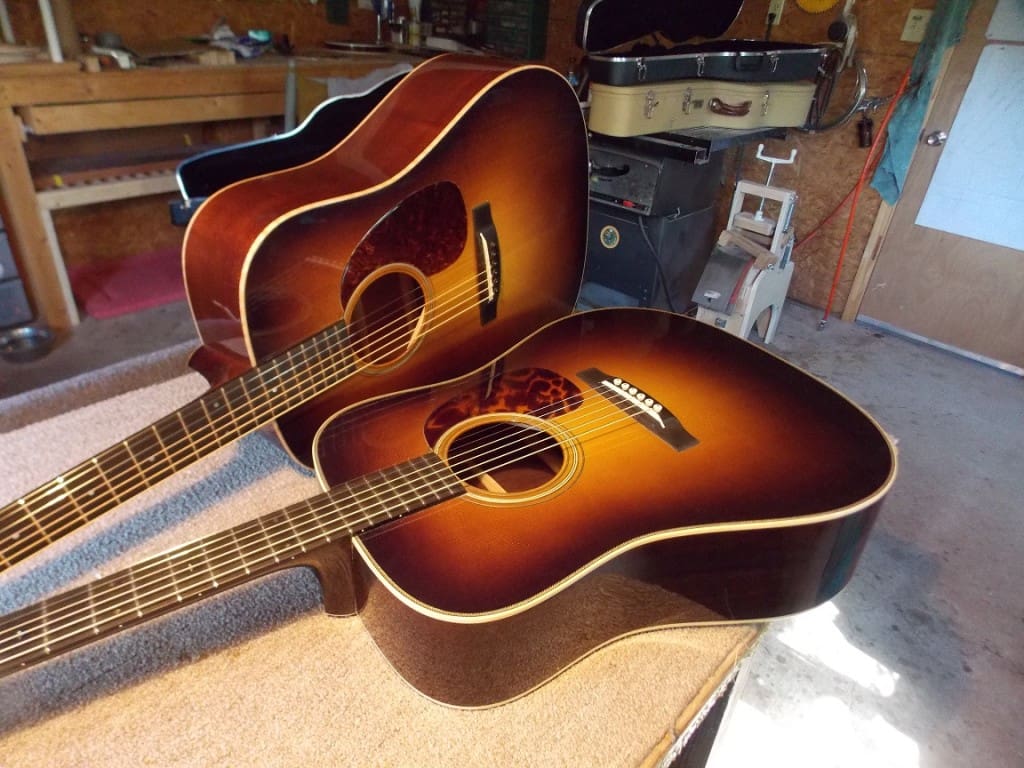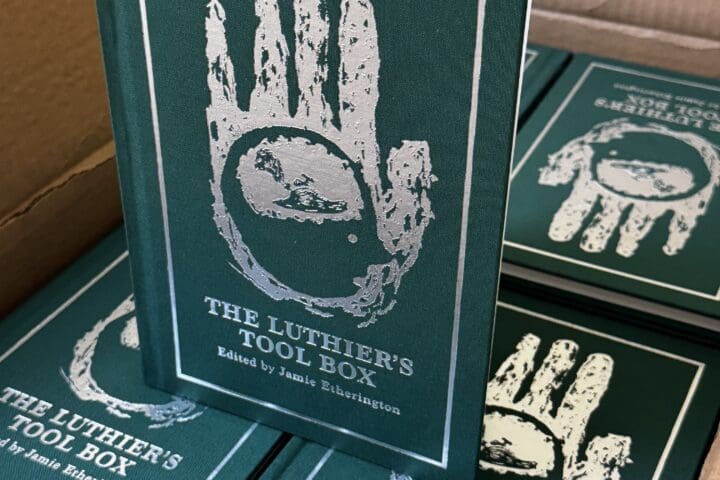Until two years ago, luthier Ken Hooper held down a day job in manufacturing management. Today, the Elkin, North Carolina resident is building guitars full-time and doing his best to manage a growing wait list of customers. Much like his mentor, Wayne Henderson, Hooper has garnered a bit of a cult following (including a 30-plus page thread on the Unofficial Martin Guitar Forum) and plenty of return customers. We decided to check in with the builder and see what’s currently on his bench.
Fretboard Journal: What are you working on right now?
Ken Hooper: I generally keep two to three instruments in various stages of completion going at one time in my shop in order to be able to continue work while glue dries or finish cures. I’m currently working on a Brazilian rosewood OM-28 that is going to be a replica of an early ‘30s model. I’m fortunate enough to have some good friends that own some of the original guitars and I never hesitate to call on them to get out the calipers or snap a picture if I need clarification on something. Additionally, I’m getting ready to carve the braces and close up the box on a D-28 style guitar. This guitar is going to be a fairly straightforward representation of a mid-‘30s Martin. It will have a Red spruce top with herringbone trim and forward-shifted braces with no popsicle [brace]. Also, I am getting ready to do the final leveling and polishing on a D-18. This guitar also is constructed in the mid ‘30s style but with a few variations on some of the appointments, as requested by the customer. It has the “Nick Lucas” inlay pattern on both the fretboard and peghead as well as having a Brazilian rosewood bridge and fretboard. It’s a sunburst guitar and the coloration is also loosely based on a Nick Lucas sunburst found by the customer. I also have a ‘56 D-28 in for a neck set and bridge replacement.
FJ: Tell us a bit about the wood and construction techniques you’re using for these instruments? Anything unusual going on?
KH: I am pretty traditional across the board when it comes to wood and construction techniques. As you can see, my guitars are modeled fairly closely after the ‘30s Martins. 95% of the guitars I build have the forward shifted brace configuration. For 28 style guitars I use a lot of Brazilian rosewood but also really like Honduran, Madagascar, Amazon and cocobolo. I’m currently building a 28 style guitar with Bolivian rosewood and I’m very excited about the possibilities for this species [Pau Ferro] as a substitute for Brazilian. For the 18 style guitars, I most always use Honduran mahogany. I was fortunate enough recently to come across a fair amount of old growth Honduran mahogany and I’m really enjoying putting it to good use. I occasionally use Cuban mahogany and I love the tonal properties of it but, as you may know, it’s really hard to get. As for the top wood, the vast majority of what I use is Red spruce. That’s not to say that other spruces can’t make fantastic guitars. It’s just that I have some really good sources for this wood and I have built enough guitars with it now that I have developed a comfort factor with its characteristics. I do like to use Sitka spruce top braces underneath the red as I believe were a lot of the pre-war Martins.
FJ: Can you tell us more about Bolivian rosewood? With Brazilian becoming more and more scarce and difficult to ship overseas, folks are always looking for great alternatives.
KH: The Bolivian rosewood D-28 I have going now is actually the first guitar that I have built using this wood. It was a set that I had had underneath my bench for sometime. Matthew Goins of Blue Chip Picks and myself got together on a D-28 for him. His only specification was that it be a D-28 so I decided to go with the Bolivian. It has a great tap tone and it’s really dense, plus the appearance is striking so I’m looking forward to result. Intuitively, as I build with it, it reminds me a lot of cocobolo… we will see. Since its going to Matt, there will be a lot of people around the country who will have the opportunity to play it at all the festivals he sets up at, so that’s pretty cool. As far as Brazilian substitutes, there are a lot of great choices I’ve used quite a bit and really like: Honduran rosewood, Madagascar, Amazon and Cocobolo. All of these have the potential to make a fantastic guitar.
FJ: Can you tell us a bit about where your workshop?
KH: My shop is located in Elkin, North Carolina right behind my house. It’s actually a two-car garage that I took over as my workshop several years ago. Growing up, we always did woodwork in the basement of my parent’s house and the dust was always an issue. It’s nice to have the workshop detached from the main house for this reason. I get kidded quite a bit by some of my former co-workers that I now have a 23 step commute to work everyday.
FJ: How did you become interested in building guitars and when did you decide to do it for a living?
KH: I first got interested in building guitars 20-plus years ago after a visit to Wayne Henderson’s shop in Rugby, Virginia, about 40 miles away from me. I always give Wayne credit as being my initial inspiration to build instruments. The first instrument I built was an F-5 mandolin from a book by Roger Siminoff. After that, I built a guitar from a kit. The actual construction of an instrument is something that I found came fairly easily to me. As I look back on it now, I realize that somehow I always knew that it was what I was supposed to be doing in life. There was so much I wanted to do with instruments but I just didn’t have enough time to get everything accomplished by working at night and on the weekends. I knew the only way I was going to accomplish what I wanted to do was by doing it full time. I have a business management degree from Appalachian State and all my previous jobs were in manufacturing management, primarily in the textile business. After a lot of soul searching and late night conversations with my wife, we took the plunge. We hope to be celebrating the business’ second anniversary this November.
FJ: Only two years! What do you attribute you quick success to?
KH: Actually, two years is a little bit misleading. Two years will be the anniversary of going full time. I’ve been building instruments for 20+ years. I was fortunate in that I had no problem selling my first guitars and they happened to end up with people that enjoyed telling other people about them. Dave McCarty bought one of my early D-18’s and really liked it. He was gracious enough that he ended up doing a write-up on me in Bluegrass Unlimited and Flatpicking Guitar magazine so I actually had a pretty good backlog of guitars when I decided to go full time. I went right to work after quitting my real job. Dave is actually on my list now for a J-35 style guitar that I’m really looking forward to. There are actually a lot of people on my list now for their second guitar, a few for their third and my all time favorite customer is on there for his fourth! He actually gets to sit at the head of the table when we have the Hooper guitar gathering! I had a gentleman from New Zealand actually order three at one time. He ordered a D-18 and OM-28 and a 00. I’m getting ready to start the 18 now. It’s really no exaggeration when I say that the vast majority of people I have built guitars for have become really close friends. That’s one of the biggest benefits of this business.
FJ: Henderson has the ultimate cult following and has appeared in the FJ several times. Can you tell us a bit about your relationship?
KH: I met Wayne back in the early ‘90s when I went with a friend to his old shop in Rugby. My friend had a D-35 that the pickguard was pulling up on. When I first walked in, I was blown away at all the sawdust, old guitars and parts of guitars, but most of all, I was blown away that someone could actually build an instrument of that caliber somewhere other than a factory. It was then that I knew I wanted to build an instrument. I have never received any “formal” training from Wayne but he’s always been there when I wanted to discuss something or had a question. I’ve learned so much from him by just going up to the shop and hanging out with him and [luthier] Don [Wilson]. I’m always amazed when I ponder how I build guitars and I realize how much of what I do I do because I picked it up at Wayne’s. Everything from the way I adjust the fit of the dovetail joint to the way I glue on a top and a back or spray finish.
FJ: You mentioned that the first instrument you built was an F-5 mandolin. Are you still building mandolins?
KH: I do build a mandolin occasionally but not on a regular basis. To date, I have built five mandolins; I really love to build them. There is something about carving the scroll that just draws me in. The only thing about mandolins is that they take so much more time to build. I plan to get into them a bit more at some point but right now, I am blessed to have quite a bit of demand for guitars so that’s pretty much where I focus. Besides, carving a neck and braces draws me in the same as a mandolin scroll so I’m in good shape!
FJ: Any general design philosophies you wish to share?
KH: My design philosophies are pretty simple really: They are pretty much pre-war Martin’s. There was an understated elegance in these instruments that I really have an appreciation for. As a general rule, they were very lightly constructed and meticulously crafted. I try to incorporate these aspects into my guitars. I always use the analogy of a hot rod when talking about guitars. On a hot rod, everything is there for a purpose. If it doesn’t contribute to making the car go fast, it’s worthless. It’s the same with a guitar. I have a lot of folks ask me about repair work. I generally tell them that I do on a limited basis but I really just do this in order to be able to stay in touch with my own design philosophies.
FJ: What’s your wait time at the moment?
KH: My wait time at the moment is getting pretty close to 24 months.
FJ: Anything coming up in the future you are particularly excited about?
KH: I always tell people that the most important guitar that I have is the one that I’m currently working on, and that’s the truth. I put my heart and soul into each and every aspect of every guitar that I build. I have several guitars coming up that I’m going to be excited about. I’m going to be doing a pre-war D-18 for Bob Minner [of Tim McGraw’s band], who is also a very discriminating vintage Martin nut such as myself. I’m also excited about building an OM-18 for a young man here in the area who is going to be a fantastic picker one of these days. He is nine years old and his parents talked to me recently about building him his first nice guitar. I told them I would be honored to.
To learn more, visit hooperguitars.com.
